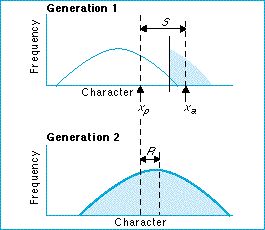Quantitative genetics - How can quantitative genetics be applied?

Directional selection
There are many ways in which quantitative genetics can be applied to understand evolution. We shall consider directional selection. Directional selection has particularly been studied through artificial selection experiments. Artificial selection is important in applied genetics, as it provides the means of improving agricultural stock and crops. If we wish to increase the value of a character by artificial selection, we can use any of a variety of selection regimes.
Truncation selection
One simple form is truncation selection, which may take two very similar forms:
• the selector picks out all individuals whose value of the character under selection is greater than a threshold value, and uses them to breed the next generation.
• the selector ranks the population in terms of the value of the character under selection, and breeds only from those with a relatively high value, discarding a fixed proportion each generation.
Figure: truncation selection: the next generation is bred from those individuals (shaded area) with a character value exceeding threshold value. The selection differential (S) is the difference between the whole population mean (Xp) and the selected subpopulation mean (X). S = Xs - Xp.
| Next |



